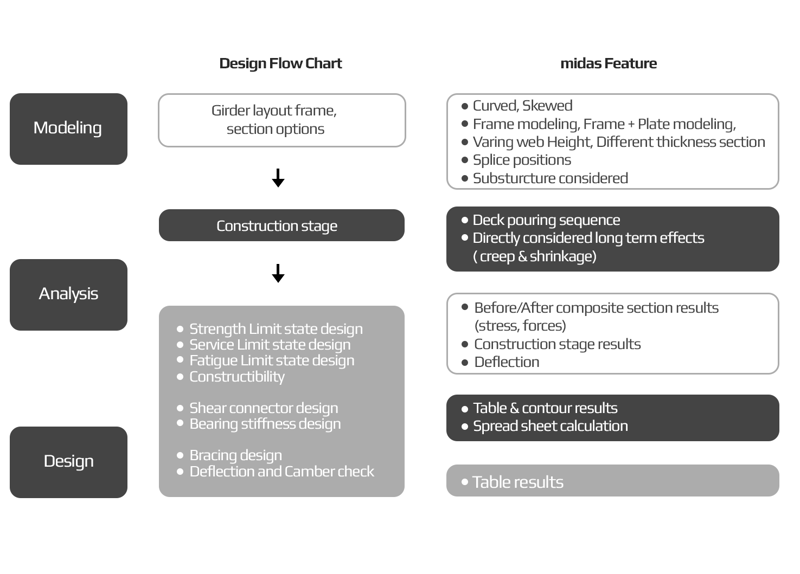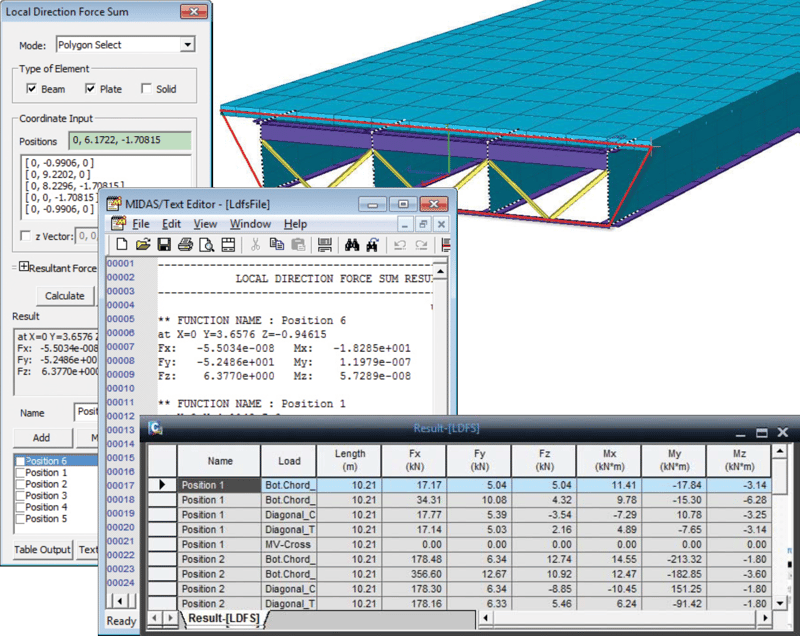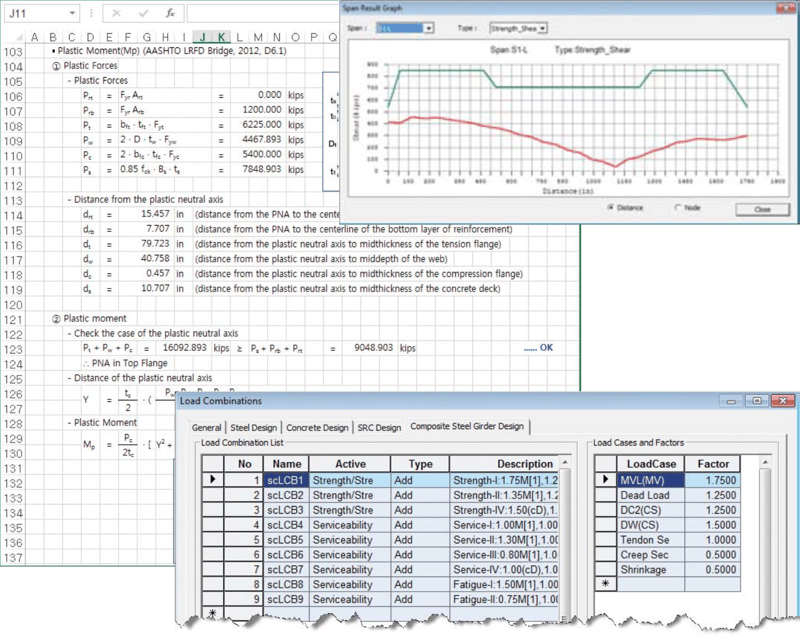A higher standard of bridge design
Staged Construction Analysis for Steel Bridges
to simplify the complicated and tedious modeling of complex steel structures while satisfying critical engineering issues such as checking girder local buckling, oil canning effect, and constructability check.
Issues in handling complex steel girder bridges’ staged construction analysis
The steel plate girder bridge is one of the most popular and widely used bridge types. Although people often misunderstand it is easy to design due to its popularity, evaluation of the stability of steel members can be troublesome. In fact, bridge designers consider not only non-composite and composite but also long-term creep and shrinkage with the effective modular ratio of n. Primarily, modeling considering varying effective width or numerous section properties must be efficient. Even small configuration variations can easily more than double the number of stages, sections, and groups required. This can be a tedious process and results in human errors.
Therefore, bridge engineers need software that automatically calculates and considers section properties in each different sequences for accurate analysis results while complex layout and construction stage of the bridge is analyzed with simple steps user intuitively. Also, it is important that engineers should be able to build full 3D shell model easily or consider local buckling effect even using a grilled modeling approach.
Process and features helpful for checking constructability of Steel Bridges

Significant Features and Differences in Results


Negative Reaction (Uplift Reaction)
The behaviors of the curved bridges, often used for the ramp or interchange, are very complicated. Special conditions like varying curve radius, steep skew angle, and irregular spacing of bearing result in higher negative reactions on the curved bridges. Engineers should be able to control the design variables such as the radius of curvature, skew angle, and spacing of bearings. In MIDAS, engineers can easily model and analyze a 3-dimensional model using the wizard or intuitive modeling methods.
Deck pouring sequence
In many cases, bridges can have different span to span ratios, continuous span, and deck pouring length and sequences. Those conditions result in varying stress of the deck. Engineers have to consider the deck pouring sequence appropriately to satisfy the constructibility limit state checking and longitudinal tensile stress limit in the concrete deck. Considering deck pouring sequences helps to control the crack in the continuous deck, tensile stress limit, and uplift reactions. Midas can check various cases of deck pouring sequence with different stages and deck length in each stage.
Buckling Analysis
Steel bridge design centers around solving and preventing buckling issues. for more detailed examination of buckling, plate elements are used to model girders, especially the web portion.
In buckling, there are a few critical variables such as the section material, the section stiffness, the slenderness ratio, and the boundary conditions of web and flanges. Therefore, it is important to simulate and evaluate various design scenarios using 3-dimensional Finite Element Analysis models.
Vibration Control
Steel bridges tend to be more vulnerable to vibration than concrete bridges due to its lighter self-weight. These vibration problems may not only affect the usability but also the possibility of resonance due to live load or earthquakes. MIDAS can perform analysis for sag and eigenvalue in 3D considering variables such as the slab thickness, span to depth ratio, etc.
Bracing Modeling
One of the most tedious tasks in steel bridge analysis is modeling the bracing members. Using MIDAS Steel Bridge wizard, engineers can model complicated bracing configuration in a simple manner - by defining geometric conditions such as spacings, gap, number per span, etc. instead of defining bracing members one by one according to their coordinate system.
Resultant Force
Curved or skewed girder bridges with composite steel plate girder are frequently simulated with plate and beam elements instead of beam elements with composite section. In case of modeling using plate elements or a combination of plate and beam elements, analysis results from multiple plate and/or beam elements should be converted to one member force for the design or rating code checking. Using the virtual beam and resultant force features in MIDAS, engineers can get resultant single member force automatically. These features allow engineers to review the resultant forces (Fx, Fy, Fz, Mx, My, and Mz) in a text/table/diagram format.
TESTIMONIAL
From user’s perspective, I think that advantages of midas Civil is It is very user friendly software. I think that options are very intuitive and well located. Graphic user interface is something I really like about this software. It allows you to check your model and check the section properties at different stages to make sure that the bridge modeled correctly. Also, fast and accurate bridge modeling especially with the bridge wizard, even at curve bridge could be modeled very quickly.
Luis J. Vila at GM2 Associates
Midas Civil program was used to investigate the lateral response of the structure to investigate pier deflections, modular joint movement, and lateral reactions at abutments. The Initial model was developed using steel composite girder bridge wizard. Midas also has capability for you can define deck pouring sequence and how much you want to pour at positive moment region first, and negative moment region later. It was nice capability. I also want to point out that midas Civil also has composite section properties that considering warping effect, when you select the option, you will get a better representation of the warping stiffness of the system.
Atalay Yargicoglu at Stanley Consultants